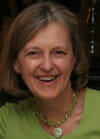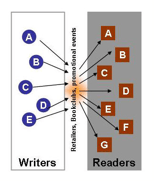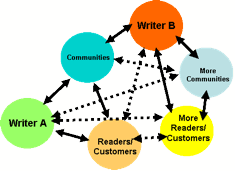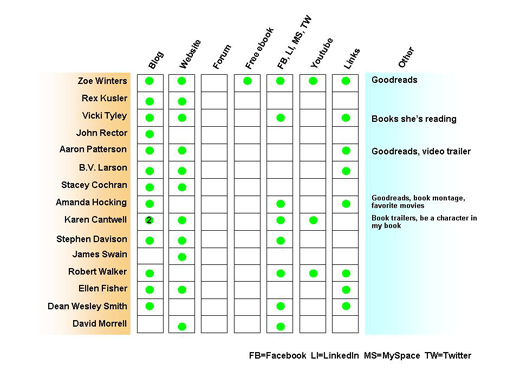
by Mary Tod
I’m pleased to have Mary Tod, novelist and blogger, as a guest on The Book Designer. I found her article a fascinating take on the changes taking place in publishing, and I bet you will too.
In the old-world model writers connected with readers primarily through intermediaries like book stores and book clubs plus the occasional public appearance at a reading or book tour. All that has changed.
In the new world, connections have multiplied and relationships are two-way and multi-dimensional rather than one-way. (Dashed lines imply secondary relationships sparked by primary ones.)
Provocatively, Kate Pullinger, fiction writer and explorer of the future of publishing, says “connecting readers to writers is the only possible future of publishing”. In the realm of self-publishing, this is even more critical. Writers need to consider how they will connect with readers and communities to facilitate at least three things: developing and improving what you offer (books, workshops, speaking engagements, online book signings, online book clubs), marketing and selling, and providing your customers with care and attention.
As a writer who publishes without the leverage of a traditional publisher, you will want to consider:
- Listening – create ways to listen to your readers and collect data about what you hear; use focus groups and surveys to support regular listening mechanisms. Make sure you respond when they ‘talk’ to you.
- Customer knowledge – find out why people buy your products (or not), why they recommend you to others (or not), why they are repeat buyers. Understand what else they buy.
- More customer knowledge – understand who your buyers are, what segment and communities they belong to.
- Conversations – find unique ways of connecting with readers, ways that will enhance your brand as an author, ways that enable dialogue not one-way broadcast.
- Collaborate – go beyond listening and conversation to collaborate with your readers, perhaps testing your products in advance of a full launch or soliciting ideas for additional content.
- Long term relationships – develop mechanisms to foster long term connections with your readers. Keep them engaged even as you create new offerings.
- Community – build a community of your readers. Facilitate mechanisms for readers to interact with one another as part of this community and to broaden the reach to additional readers.
Learning By Example
Can we learn by example? Joe Konrath received significant publicity for doing a deal to directly publish his latest book with Amazon. What does he do to connect with readers?
On JAKonrath.com he lists his books and provides a forum for readers to discuss various topics including the books themselves. In addition to a blog about writing and publishing, he has a page on Crimespace.com (not very active), he’s on Facebook, he uses Goodreads to list his books, link to fans and friends and comment about other authors he reads, he has a blog on Amazon although the link on his main blog doesn’t work, he’s on LinkedIn and MySpace where readers can post a picture on his guest book and make comments, he does author blog tours, he offers free books (not his Jack Daniels books), he’s on Shelfari (but hasn’t visited since May 2009), Squidoo, ITW (International Thriller Writers) and Twitter.
Phew – that’s a lot of connecting!
John Kremer, author of 1001 Ways to Market Your Books and a blog about book marketing had a long list of self-published authors who have gone on to success. Here’s what a few of them are doing.
- Richard Bolles, author of What Color is Your Parachute, initially self-published. Bolles is famous for the advice he offers regarding career change and has sold more than 9 million copies of his original book. On his website, he offers articles and advice on a wide range of job search and career matters as well as links to well known job websites like monster.com.
- Vicky Lansky, author of Feed Me I’m Yours and other parenting and household advice books and columns, has a website, with information about all her books (and how to order them) as well as free tips on various subjects.
- Mark Pearson, author of Europe from a Backpack, offers ways to connect with other travelers through social media groups, has a blog (last post was in 2009), has a newsletter, the ability to order books and read a sample of each book, and offers useful links for travellers. His website is here.
- James Redfield, author of The Celestine Prophecy, originally self-published. His first book spent many weeks on the NYT best sellers list. His website Celestine Vision, which he shares with his wife, offers several features: an active forum for people to discuss various topics, a newsletter, information about the Celestine insights, links to a very long list of other websites and people, the movie trailer, information about his other books as well as the ability to order them.
- Thriller author, Boyd Morrison, self-published The Ark on Amazon.com and was subsequently signed by Simon & Schuster. Morrison has a website listing his books and upcoming events as well as the audio from radio interviews and a blog (last updated mid-2009).
- Lisa Genova, author of Still Alice, has a blog focused on her novel as well as information about Alzheimer’s and links various sites. The last post is February 2010. She also has an official author website at Simon & Schuster.
Let’s have a look at a few other self-published authors:
Conclusions?
- Non-fiction by its very nature enables more varied connections to customers.
- A blog or website is a must, however, a blog allows for more dialogue between writers and readers and amongst readers.
- Forums are an intriguing way to connect with a community of readers (or others) to discuss specific topics and gain the benefit of a range of input.
- As far as I can tell, the authors sampled are not gathering information about their customers/readers.
- Be selective. A blog where the latest post is nine months ago doesn’t give readers and others a reason to return.
- Most writers are broadcasting rather than engaging.
What you do will depend on how you plan to operate your writing business and technology will facilitate many aspects of building relationships. Being reader-centered can bring new dimensions to how and what you write. Being reader-centered requires you to connect with authenticity and openness, fostering the ecosystem of the writing industry.
 Mary Tod is a writer of fiction with 30 years of business experience. Her blog, One Writer’s Voice, is designed to share ideas and reflections on historical fiction and the business of writing. She is also the author of two novels and writes another blog, Found Diary, from one of her character’s point of view.
Mary Tod is a writer of fiction with 30 years of business experience. Her blog, One Writer’s Voice, is designed to share ideas and reflections on historical fiction and the business of writing. She is also the author of two novels and writes another blog, Found Diary, from one of her character’s point of view.
Photo: Junior Gomes via Stock.xchng





